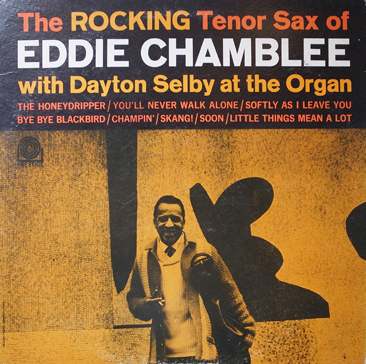Party time with Eddie Chamblee.
Personnel
Eddie Chamblee (tenor saxophone), Dayton Shelby (organ), Al Griffin (drums)
Recorded
on February 27, 1964 at Van Gelder Studio, Englewood Cliffs, New Jersey
Released
as PRLP 7321 in 1964
Track listing
Side A:
The Honeydripper
You’ll Never Walk Alone
Softly, As I Love You
Bye Bye Blackbird
Side B:
Champin’
Skang!
Soon
Little Things Mean A Lot
Eddie Chamblee was born in Atlanta in 1920. He was the featured tenorist on Sonny Thompson’s big hits
Long Gone and
Late Freight and played in the groups of Lionel Hampton, Cozy Cole, Amos Milburn, T-Bone Walker, Lowell Fulson, Machito and singer Dinah Washington, with whom Chamblee was married for a short period. While leading his own groups, the tenor saxophonist played on r&b and doowop tunes, notably by The Diamonds and The Drifters. The liner notes writer of
The Rocking Tenor Sax mentions two funny details. Firstly, Chamblee is the tenor saxophonist that the viewer notices standing beside Brigitte Bardot in Roger Vadim’s movie
And God Created Woman. Secondly, Chamblee performed at the Inaugaration Party of President Eisenhower in 1956. If you had to choose between one of these supporting roles, which one would it be? Rejoining Hampton in the eighties, Chamblee was further associated with Milt Buckner and Count Basie. Chamblee passed away in 1999.
Prior to his affiliation with Prestige, Chamblee recorded two albums for EmArcy, Chamblee Music and Doodlin’. The Rocking Tenor Sax is Chamblee’s only album as a leader in the sixties. The title is a great reflection of the kind of roaring live gigs one could experience in those days. It isn’t live-in-performance but it feels that way. Obviously, the legendary engineer Rudy van Gelder at work here, beware that no one took notice of his innovative recording methods, rarely invited neighbours, relatives or friends. Would’ve been one hell of a party.
Soul jazz grew out of swing, r&b and modern jazz. Generally speaking, it was an Afro-American phenomenon, a type of music that was enjoyed in clubs and bars around the country but particularly popular in the Mid-West. Though there’s no mistaking that most players had a solid background in modern jazz, (by the way, part of the work of giants of jazz like Cannonball Adderley or Sonny Stitt is also categorized as soul jazz – Adderley’s Jive Samba was a big hit) entertainment was key. Soul jazz was, first and foremost, accessible, finger-poppin’, foot-tappin’, hip-shakin’ music for a night out into town. The pioneering, relatively small independent record companies presented a catalogue of blues, ballads, American songbook and popular tunes – groove music. Prestige, Blue Note and Argo/Cadet possessed a good distribution network and carried their stock to radio stations and the jukebox circuit, hoping for a hit record or single. A hit didn’t necessarily have to be an original composition. There are many examples of interpretations of hits by artists which also turned into big sellers. The Honeydripper, the opening cut from Eddie Chamblee’s Prestige album is a case in point. It was a hit for the original writer, Joe Liggins. Soon after, Roosevelt Sykes made a successful version. The take on the contagious r&b melody by Eddie Chamblee didn’t lead to skyrocketing sales. But no doubt, his rousing version blows the roof off the joint.
Said Honeydripper has Chamblee climaxing early but not necessarily too soon, if you know what I mean. Chamblee’s got plenty of juice, honking his way through the choruses and the rocking 4/4 bottom that drummer Al Griffin provides. Chamblee alternates growls with screeching high notes, a specialty that Chamblee demonstrates on other tunes on the album as well. There goes Van Gelder’s Delft Blue tableware. Chamblee shows no signs of fatigue, providing effective swing riffs behind organist Dayton Shelby, who’s quite the musical rebel rouser himself.
It’s easy to imagine Chamblee’s trio perform at one of the dingier clubs on The Street. Some colorful cat offers a beauty a drink, the chatter of customers pierces little holes in the cigarette smoke clouds… And Chamblee bounces through his original tunes Champin’ and Skang!, the former a sleazy jump blues, the latter a slow, down-home blues. There’s the hard rock (like, hard rock) of Bye Bye Blackbird, courtesy of the bulldozer drum patterns by Al Griffin. And while Softly As I Leave You is a pretty sapless attempt to balladeer gent and dame into the French Kissin’ zone, embellished by lachrymose organ playing, Soon finds a soft spot in the heart. The Gershwin composition is gracefully marked by Chamblee’s velvet yet peppery lines and beautifully inflected notes. Here Chamblee has reached a synthesis between suppleness and groove. Soon is the highlight of The Rocking Tenor Sax Of Eddie Chamblee, but it can’t hurt to keep the remainder of the repertory in mind for a house party. Satisfaction guaranteed.
Listen to the full album on YouTube here. And to Eddie Chamblee on Spotify below:









